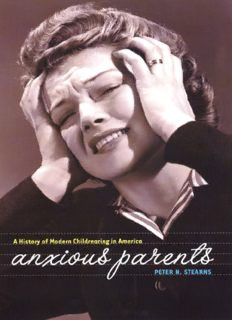
Anxious Parents: A History of Modern Childrearing in America PDF
Preview Anxious Parents: A History of Modern Childrearing in America
ANXIOUS PARENTS PETER N. STEARNS ANXIOUS PARENTS A History of Modern Childrearing in America a New York University Press • New York and London NEW YORK UNIVERSITY PRESS New York and London © 2003 by New York University All rights reserved Library of Congress Cataloging-in-Publication Data Stearns, Peter N. Anxious parents : a history of modern childbearing in America / Peter N. Stearns p. cm. Includes bibliographical references and index. ISBN 0-8147-9829-2 (cloth : alk. paper) 1. Child rearing—United States—History—20th century. 2. Parenting—United States—History—20th century. 3. Parent and child—United States—History—20th century. 4. Child development—United States—History—20th century. I. Title. HQ769 .S76 2002 649'.1'0973—dc21 2002152802 New York University Press books are printed on acid-free paper, and their binding materials are chosen for strength and durability. Manufactured in the United States of America 10 9 8 7 6 5 4 3 2 1 For my children and stepchildren. Are you o.k.? Contents Preface ix Acknowledgments xi 1 Anxious Parents: A20th-Century History 1 2 The Vulnerable Child 17 3 Discipline 57 4 All Are above Average: Children at School 81 5 Work and Chores: Do I Have To? 125 6 I’m Bored: The Two Faces of Entertainment 163 7 Conclusion: The Impact of Anxiety 211 Appendix 233 Notes 235 Index 245 About the Author 251 vii Preface THIS BOOK IS DESIGNED to inform the challenge of contemporary parenting by discussing some significant changes in child-adult rela- tions in the past several decades. It is not a how-to book, of the sort that dominates parenting shelves in the bookstores. Rather, it is an orienta- tion to the history of modern parenting and to the connections of past to present; as such, it offers considerable understanding of how-not-to, which is important in its own right. Why is it that American parents so often get caught up in worries that they lose perspective on some of the basic goals and pleasures of parenting? Understanding the sources and locations of some key anxi- eties can help us decide what’s worth worrying about. And the process that brought us to our current anxieties is interesting and revealing in its own right, which adds to the pleasure of contemplation. We need to know, and we can know, how we got to where we are today, distresses and all. The basic argument is not complicated. Several decades back, many American parents, and those who advised them, began to change their ideas about children’s nature, attributing to it a greater sense of vulner- ability and frailty. This new view then influenced the handling of mat- ters within the family, such as discipline and chores. It also affected the ways parents tried to mediate between children and other experiences that affected them, such as schooling or recreation. Some of our most striking practices, from grade inflation to worries about children’s bore- dom, result from the intersection of beliefs in vulnerability and the in- fluence of wider social institutions. ix
Description: